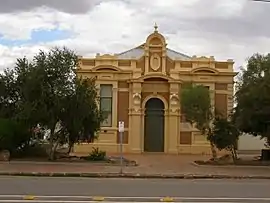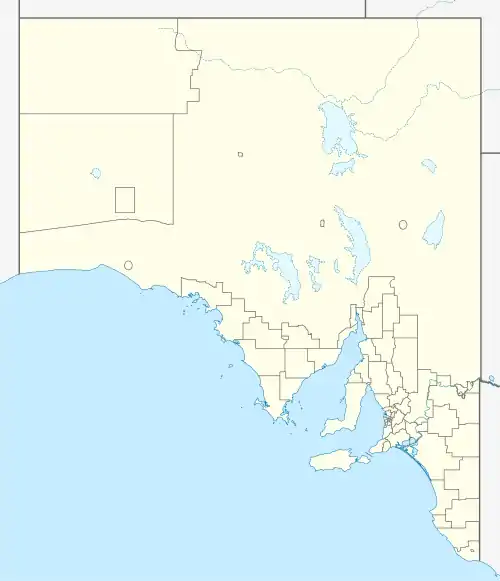District Council of Kanyaka
The District Council of Kanyaka was a local government area in South Australia that existed from 1888 to 1969.
| District Council of Kanyaka South Australia | |||||||||||||||
|---|---|---|---|---|---|---|---|---|---|---|---|---|---|---|---|
 Quorn Town Hall was shared by Quorn and Kanyaka councils | |||||||||||||||
 District Council of Kanyaka | |||||||||||||||
| Coordinates | 32°10′S 138°10′E | ||||||||||||||
| Established | 1888 | ||||||||||||||
| Abolished | 1969 | ||||||||||||||
| Council seat | Quorn | ||||||||||||||
| |||||||||||||||
History
The council was established on 5 January 1888 under the provisions of the District Councils Act 1887. On creation, the council comprised the hundreds of Boolcunda, Cudlamudla, Kanyaka, Moockra and Palmer, and parts of the hundreds of Pichi Richi, Yarrah and Wyacca, east of the Middle Range and Dutchman's Range ridge line, which together make up the eastern two thirds of the County of Newcastle.[1] The council area thus extended north and east from Pichi Richi Pass (about 10 km (6.2 mi) southwest of Quorn) to a point about 10 km (6.2 mi) due south of Hawker.
The council was initially based out of the Quorn Town Hall, but later was housed in an office converted from a house in Eighth Street, Quorn. Both buildings were actually not in the council area, being instead within the Corporate Town of Quorn which was an enclave surrounded by Kanyaka council from 1888. Both the town hall and later office survive as of 2015; the latter building has reverted to residential use.[2][3]
On 16 February 1933, the council gained a section of the abolished District Council of Woolundunga, which became the new Mundallio Ward.[4] By 1936, the council had seven wards (Pichi Richi, Suburban, Palmer, Boolcunda, Kanyaka, Mundallio and Yarrah), was reported to have a population of approximately 1,000, and was said to be one of the northernmost councils in South Australia.[5]
It merged with the Corporate Town of Quorn on 1 April 1969 to form the District Council of Kanyaka-Quorn.[6]
Chairmen
- C. Meincke (1888) [7]
- W. H. Neal (1902-1904) [8][9][10]
- G. H. Willis (1904-1905) [11][12]
- David William Stanley Stokes (1932-1937)[13]
- Francis William Hannan (1937-1942) [13]
- David William Stanley Stokes (1942-1946) [13]
- Francis William Hannan (1946-1947) [13]
- James Francis Reid (1947-1956) [13]
- Paul Oscar Eckert (1956-1958) [13]
- Oliver McHugh (1958-1963) [13]
- John Denton French (1963-1969) [13]
References
- "The District Councils Act 1887 No. 419". Government of South Australia. Retrieved 14 November 2015 – via Flinders University.
- "Population Of Quorn". The Advertiser. Adelaide, SA: National Library of Australia. 11 October 1954. p. 4. Retrieved 14 November 2015.
- "Quorn Historic Buildings Walk" (PDF). Flinders Rangers Visitor Information Centre. Archived from the original (PDF) on 8 December 2015. Retrieved 2 December 2015.
- Marsden, Susan (2012). "A History of South Australian Councils to 1936" (PDF). Local Government Association of South Australia. p. 11. Retrieved 30 October 2015.
- Hosking, P. (1936). The Official civic record of South Australia : centenary year, 1936. Adelaide: Universal Publicity Company. p. 619.
- Aitchison, D. L. J. (1975). Statistical Register of South Australia, 1972-73. p. 17.
- "Kanyaka District Council". The Port Augusta Dispatch, Newcastle and Flinders Chronicle. SA: National Library of Australia. 7 February 1888. p. 2. Retrieved 14 November 2015.
- "KANYAKA". Petersburg Times. SA: National Library of Australia. 28 February 1902. p. 3. Retrieved 14 November 2015.
- "District Council". Petersburg Times. SA: National Library of Australia. 8 September 1903. p. 1. Retrieved 14 November 2015.
- "District Council". Petersburg Times. SA: National Library of Australia. 23 February 1904. p. 1. Retrieved 14 November 2015.
- "District Councils". Petersburg Times. SA: National Library of Australia. 9 August 1904. p. 1. Retrieved 14 November 2015.
- "District Council". Petersburg Times. SA: National Library of Australia. 24 January 1905. p. 4. Retrieved 14 November 2015.
- Matthews, Penny (1986), South Australia, the civic record, 1836-1986, Wakefield Press, pp. 368–372, ISBN 978-0-949268-82-2